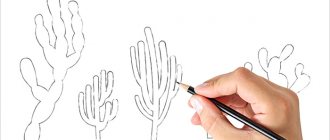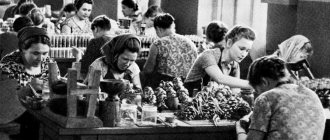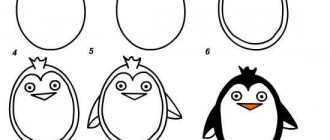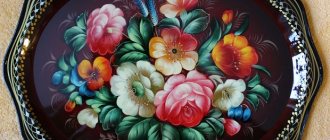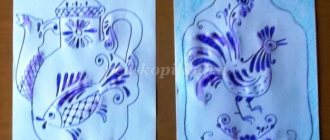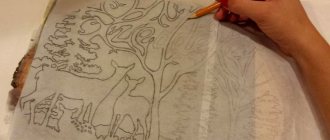One of the oldest crafts of arts and crafts in Russia is Khokhloma painting. For more than three hundred years, craftsmen have been making incredibly beautiful dishes, which can already be called the calling card of the Russian people. The process of creating a masterpiece is quite complex; it includes both the creation of blanks and their processing, as well as further painting. But anyone can master this skill; you just need to learn about the characteristic features of the creative process.
One of the oldest crafts of arts and crafts in Russia is Khokhloma painting
Types of folk crafts and paintings
Russian regions are rich and diverse both in their landscapes and in their customs and traditions. Many places even have their own dialect. All this shaped the culture and artistic creativity of every corner of our country. For a long time, different traditions of folk crafts have developed. The most famous include the following:
- Dymkovo, Filimonovskaya, Bogorodskaya toy;
- Gzhel ceramics;
- Vologda and Vyatka lace;
- Tula samovars;
- Rostov enamel;
- Mstera, Fedoskino, Palekh miniatures;
- Zhostovo trays;
- Gorodets, Khokhloma painting.
Each of them is very original and unique, but they all reflect the culture and spirituality of the Russian people.
We perform the technique of horse writing with our own hands
This technique is quite simple and consists of applying patterns of red, yellow or black colors to the processed workpiece. As a rule, this technique is used to draw a gingerbread pattern, when smaller elements of the ornament are applied around a large central pattern.
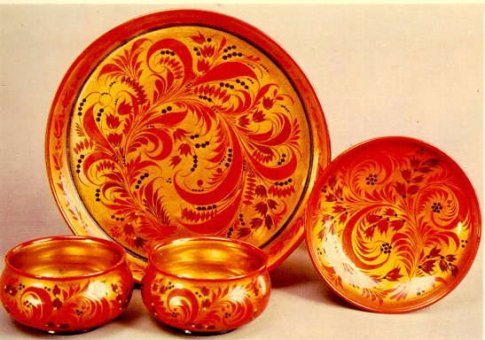
To obtain drawings using this technique, large colored patterns are initially applied, then a black background is applied to the free space and, after the paint dries, the “Grass” pattern is applied on top. The finished product is coated several times with a special fixative varnish, drying each layer, and sent to an oven heated to 150 degrees for 4 - 5 hours until a golden-bronze film is formed.
Despite the fact that the motives of the Khokhloma paintings are quite clearly defined, real masters approach this process creatively and constantly come up with new intricate images of fabulous animals, birds and plants. Beginners, due to lack of experience, are allowed to use a stencil to apply a pattern or simple patterns for training.
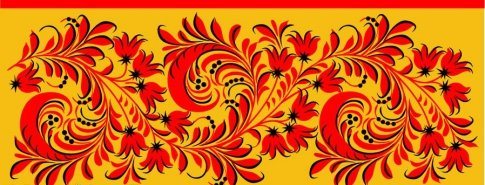
But before you start training in Khokhloma painting, you need to prepare all the necessary materials and tools. And here a corresponding question arises: what do the masters of this art use to draw such intricate curves and curls? Basically, Khokhloma craftsmen use brushes made from squirrel tails - with its help you can draw both thin and thick lines, just by changing the pressure.
It is impossible to make full-fledged kitchen utensils from which food could be eaten at home, but making a souvenir to decorate the kitchen is quite accessible to anyone.
What objects are decorated with Khokhloma painting
Traditionally, any household items made of wood were made in this style:

- spoons;
- nesting dolls;
- trays;
- dishes;
- caskets;
- chests;
- barrels;
- boxes;
- spinning wheels;
- handles and handles;
- vases;
- cutting and decorative boards.
In its modern version, when interest in Russian folk motifs is quite high, Khokhloma painting sometimes appears on very exotic surfaces:
- fabric (for bed linen, for example);
- nails;
- keychains;
- lighters;
- screen and panels of a smartphone or laptop;
- body (tattoo and body art);
- cars (airbrushing);
- bags (paper and plastic).
Thus, almost any object can now be decorated with Khokhloma painting.
History of the fishery
There are many legends about how the famous Khokhloma craft originated. The first written historical mentions of the village of Khokhloma date back to the sixteenth century.
Origin - beginning of the 17th century
Even under Tsar Ivan Vasilyevich they knew about the place “Khokhlomskaya Ukhozheya” (Ukhozheya is land cleared of forest, prepared for arable land (obsolete)). The land was infertile. Peasants have long earned their livelihood by carving simple wooden utensils - spoons, pots, bowls, kvass and jugs in the form of birds, boats (ships) and animals. The products were unpainted and coated with drying oil for strength.
Some peasants went to work. Many went to the Trinity-Sergius Lavra, to which the Volga lands and villages were “assigned”. There, craftsmen painted wooden mugs and ladles, gilded cups, served on patronal feasts with gold and cinnabar.
At the beginning of the seventeenth century, Old Believers fled to the Trans-Volga forests, who began to be called “Kerzhaks”. They did not accept the patriarch’s decree, and settled throughout vast Siberia, in the forests of the Trans-Urals. Many settled in the impenetrable thickets of the Volga region. The schismatics brought with them icons, ancient letters, books, and utensils. Among them were icon painters who knew many of the secrets of painting. To survive in harsh lands, they began to decorate wooden utensils.
And simple kitchen utensils from Khokhloma blossomed with beautiful patterns that did not leave a single person indifferent.
Khokhloma in the USSR
Khokhloma production survived the collapse of Tsarist Russia, fell into decline many times and was revived again. After the collapse of the USSR, many workshops stopped working. In modern Russia there are two main production centers - the city of Semenov - the capital of golden Khokhloma, with the Semenovskaya Painting factory and the Khokhloma Painting enterprise. And also the village of Seminos and the production of “Khokhloma Artist”.
In the seventies, masters were invited to Kursk for training. This is how the famous Kursk hand painting was born. At first, the masters painted according to samples, and then their unique features appeared - a green background, a golden border. The rich ornaments of Sujan carpets were embodied in paintings with poppies and wildflowers. Interesting ideas arose for making vases and sugar bowls in the shape of ducks and cockerels.
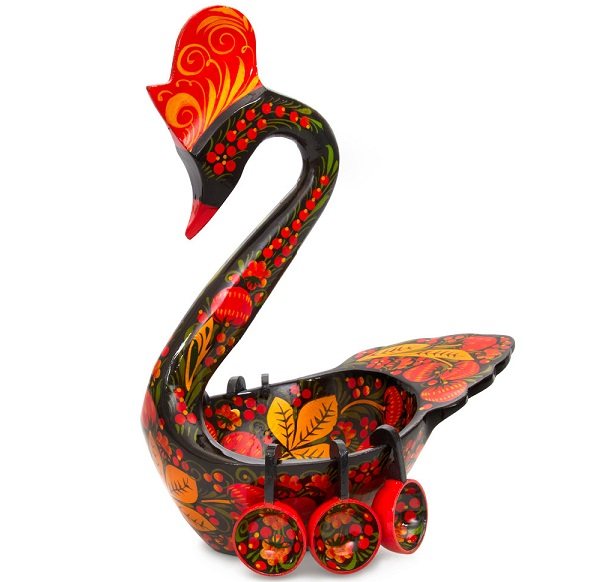
Painting in blue and cyan on a silver background - a creative discovery of masters from Vologda, began to be called “Northern Khokhloma”. In her drawings with traditional grass, northern berries appear - blueberries, cranberries.
Samples on paper
If you are new to this business and are just starting to master the basics of drawing Khokhloma painting, it is better to practice on ordinary Whatman paper. As exercises for positioning your hand, choose simple elements: berries, leaves.
All of them are based on certain movements of the brush. Even if you later work on the finished pencil outline, the circles and curls should be even. It is better to do them in one go.
If you want to know how to learn how to draw a crested child, it is best to master this technique with him, also on paper. The same type of exercise in the form of leaves and berries quickly gets boring for children, so suggest depicting a round tray, plate, spoon or vase. Make the shape of the object yourself, and give your child the opportunity to decorate the object.
Elements of Khokhloma for preschool children: step-by-step templates
Even a small child can create a Khokhlo pattern with his own hands, having mastered basic skills . Children's drawings have always been valued and pleased the eyes of parents. Often, an activity such as applique is carried out in the senior or preparatory group of a kindergarten. To create a pattern, it is enough to make a stamp from a tube and paper into which the paint will be dipped. Smaller elements are already painted with a brush, as in the pictures.
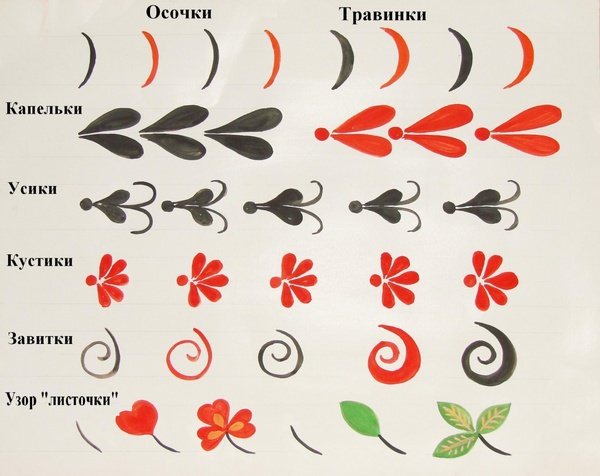
Even a small child can create a Khokhlo pattern with his own hands, having mastered basic skills
Drawing with children:
- lingonberry. Using a stamp, red circles are drawn, which do not need to be supplemented with other elements;
- currant. Berry circles are collected near a blade of grass, on which golden dots must be placed with a brush;
- Rowan. Berries are drawn with a stamp, and fairly narrow and elongated droplets are added with a brush, as well as leaves at the base of the resulting bunch. Additionally, you need to make inclusions of gold color;
- raspberries. Six circles are drawn with a stamp, without maintaining a certain distance, but slightly overlapping one on one. Highlights are added using the grass blade technique. Additionally, dots are placed with a brush;
- sepal. Blades of grass are gathered together, a twig and leaves are drawn.
Purchasing materials
Choose the right base. The shape can be round, rectangular, square, or complex carved. It is better if the board has a hole to hang it on a nail or hook. Avoid using plywood or untreated wood. The surface for applying the pattern must be smooth, without depressions, notches and burrs. The easiest way is to buy a high-quality base at a craft store. If this is not possible, but there is a board ready to size, properly treat the surface with sandpaper. If this is not done, all the unevenness will remain after applying the paint. They can interfere with the perception of the drawing and will interfere with drawing.
Painted Khokhloma box: master class
The very name of this product indicates its nobility and grace. The box turns out to be fabulous, traditionally colorful, but very unusual.
What you will need:
- paints;
- background paint (bronze or copper);
- masking tape;
- squirrel brushes;
- varnish;
- varnish brush;
- pencil;
- tracing paper;
- sandpaper;
- wooden box.
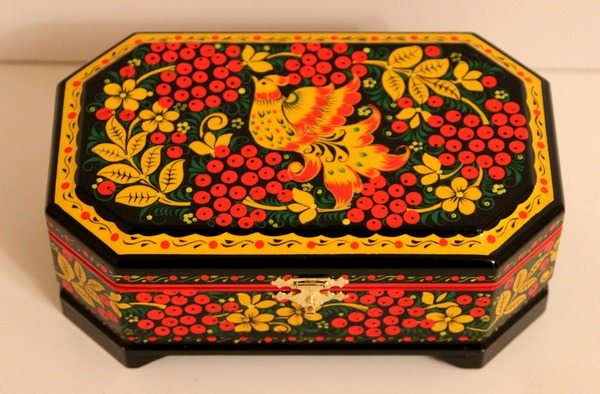
The box turns out fabulous, traditionally colorful, but very unusual
Progress:
- Plaster all uneven areas on the box. Only after the surface becomes smooth can you begin to work.
- Cover the surface of the product with background paint and wait until it dries.
- Draw a drawing on paper that will later be applied to the box.
- After the box has dried, transfer the prepared sketch onto it with a pencil. To do this, attach the paper to the box itself using tape.
- Outline the design with black paint using the thinnest brush.
- Paint larger elements black as well.
- Wait until the black paint dries.
- After this, paint all the other elements and give the paint more time to dry.
- Additionally decorate the product with tendrils and droplets.
Apply varnish to the box (at least two layers) and let it dry.
Pattern selection
Choose a suitable ornament motif. It doesn’t matter whether your Khokhloma painting will be simple or complex. Step-by-step drawing of each element will help you depict any object from a combination of twigs, leaves and berries to an exclusive bird of paradise. You just need to do everything piece by piece from simple to complex. Given the availability of computer technology, anyone can find the necessary image on the Internet, print it, for example, on film, and transfer the contours to a wooden base. It is more difficult to draw lines on a round surface. However, in this case, you can simplify your task by making several stencils of repeating elements.
Khokhloma: manufacturing technology
The process of beautiful wooden products occurs in several stages:
- Receiving “linen” - white, undyed products. The master shapes future spoons, tea cups, boxes and souvenirs from prepared wooden blocks, removing shavings from the wood with a lathe. Then the finished product is dried at a temperature of 22-28 ° C for 3-20 days.
- Vapor putty - unpainted items are coated several times after drying with special purified clay and left for 7-8 hours.
- Primer – drying oil 3-4 times (coated with layers of boiled linseed oil). Products are manually impregnated with drying oil, rubbing it in with special leather swabs. After the next impregnation, it is dried in a special cabinet at a temperature of 40-50 ° C. Then, after cooling, it is lightly sanded.
- “Tinning” - giving the product a silver or golden background. For silver color, aluminum powder is manually rubbed into the surface using leather sheepskin swabs. For gold, ground tin is applied. Then they are coated with special mixtures and fired several times in the oven until a sunny golden color is obtained. After which the product falls into the hands of master artists of decorative and applied arts.
Which color to choose?
You will need paints that are suitable for wood surfaces. The simplest and cheapest option is gouache. However, it does not form a waterproof surface once dry. It is necessary to add PVA glue to it, about a quarter of the volume of pigment, but not every color will respond well to this combination. It’s better not to take risks, but simply coat the finished product with transparent wood varnish. This will protect the drawing from moisture and other adverse factors. Another option is to use acrylic paints. They are waterproof and suitable for wood. Moreover, after such a layer has dried, you can even apply gouache on top. This means that the black background can be done with acrylic, and the pattern itself can be done with gouache.
Buy several brushes with fine tips. Squirrel, kolinsky and synthetic numbers from the first and above are suitable. The quantity and size depend on your design. You will need a thin brush in any case, and you can determine the maximum size visually depending on the planned design.
Decorating a kitchen board: Khokhloma painting on wood step by step
Khokhloma painting is more often used when drawing on wood . Craftsmen often resort to decorating kitchen boards with classic patterns. This product can be presented as a souvenir to guests, or you can decorate your own kitchen.
What you will need:
- cutting board;
- glue;
- gouache;
- egg white;
- paper;
- pencil;
- paint brushes;
- varnish;
- paint brush.
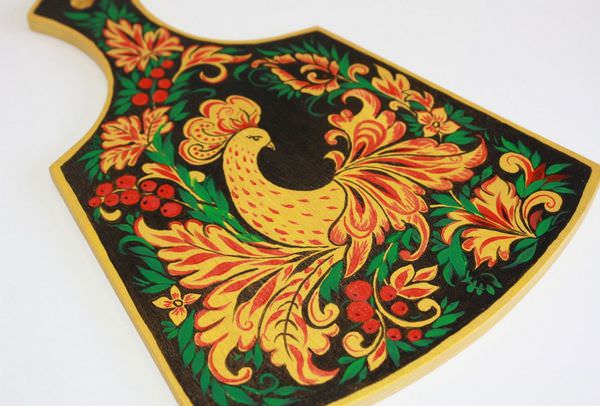
Khokhloma painting is more often used when painting on wood.
Progress:
- Coat the board with egg white and leave to dry.
- Take paper and draw a sketch on it with a pencil.
- Now apply gold paint to the board and let it dry.
- Transfer the drawing to the board.
- Color floral patterns and berries red.
- Draw the stems and veins with thin stripes.
- Thinly outline all the contours with a brush.
- Color the board so that the drawing appears on a black background.
- After the paint has dried, continue painting.
- Add green grass.
After the board has completely dried, apply varnish to its entire surface.
what it is? Khokhloma: pictures, patterns, photos
Khokhloma - what is it? First of all, this is an ancient Russian folk craft. Khokhloma painting, golden Khokhloma, a vast layer of Russian culture. The symbol of painting in the Khokhloma style is the fiery Firebird, a fairy-tale character. The capital of the fishery is the city of Semenov, located north of Nizhny Novgorod. Unlike Gzhel artistic production, which unites 27 villages into one “bush,” Khokhloma was concentrated in one place. Therefore, its development continued for quite a long time. The artistic component of the craft was also important, since talented craftsmen were not found often, and there was no training as such.
History of the Golden Khokhloma
The artistic craft of Khokhloma goes back to the end of the 17th century, during the rapid flowering of icon painting. The period of settlement of the Novgorod lands by Old Believers, who did not accept the church reform of Patriarch Nikon, coincided with the emergence of new methods of gilding icons. It was in the Nizhny Novgorod lands, villages and villages that they learned to paint icons with gold, but without the use of precious metal. The wooden frames of the icons were sprinkled with silver, ground into dust, then covered with a layer of linseed oil and placed in the oven. The silver coating miraculously turned into sparkling gold. The technologies of that time did not provide additional means to facilitate the process; everything was done manually. Some masters somehow adapted, came up with simple tools to help themselves, but in general, Khokhloma painting was completely achieved only by manual labor. The main tasks of production were turning work, which required certain qualifications. The blanks were turned by some craftsmen, primed and burned by others, and painted by still others. But in any case, the results of joint work were good and production flourished.
The Birth of High Art
This is how gold painting of Khokhloma appeared on the Volga. They quickly moved from icons to the production of wooden utensils covered with gold designs. Silver was in short supply and was replaced with tin. The drawings did not become worse; on the contrary, the painting acquired a noble matte shade, and after polishing the paints began to sparkle like the sun. Semyonov artists began to unite in artels, and Khokhloma painting became widely known far beyond the borders of the Nizhny Novgorod province. Merchants came one after another, ordered painted wooden dishes from the craftsmen in huge quantities, and the trade began to develop at a rapid pace.
At first, spoons and scoops were carved from linden and painted with Khokhloma patterns. Grateful descendants even erected a monument to Semyon the Spooner as a tribute to the craftsmen and artists of that time. Craftsmen worked tirelessly, brought Nizhny Novgorod dishes and successfully sold them at the great Makaryevsky market, the most famous Russian fair. The dishes also reached Moscow. In the capital of Russia at that time, foreign representatives of the merchant class, Germans, French, and English were constantly present. They immediately drew attention to the unusual Khokhloma goods.
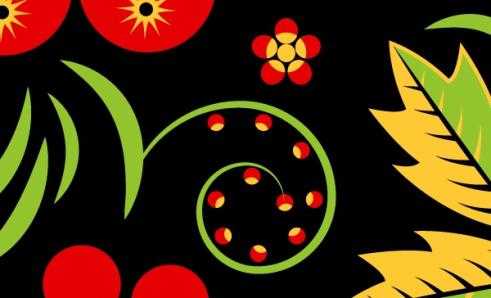
Khokhloma - what is it from the point of view of the world community?
In the mid-19th century, Khokhloma painting on dishes, furniture and clothing became known abroad. The World Exhibition in Paris, held in 1889, opened the way for Golden Khokhloma throughout the world. Khokhloma painting was exported in large numbers. The markets of Western Europe, Southeast Asia, India, China, and later the North American continent traded in Russian handicrafts.
The high demand for products of Trans-Volga craftsmen became an incentive for the further development of Golden Khokhloma. The range of production increased many times over; in addition to spoons, dishes and plates, barrels, jars for spices, salt shakers, various accessories, glasses and mugs were produced. Especially valued in the West were the so-called bratins - huge vessels in the shape of a boat with a dozen ladles. The name spoke for itself; this dish was intended for a fraternal feast. A festive theme has always accompanied Khokhloma products. And the inexhaustible source of plots and themes for them is all of Russia. Khokhloma is inextricably linked with both the source itself and its history.
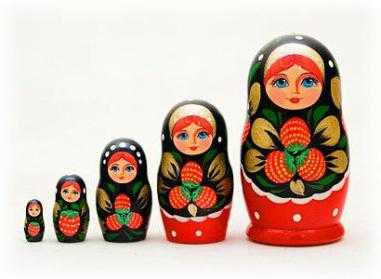
Dishes and more
In addition to dishes, household items were produced in large series: boxes, snuff boxes, small furniture items, towers, cabinets, tables and benches. It was possible to order golden Khokhloma, it cost an order of magnitude more, but the price did not bother anyone. By the end of the 19th century, Khokhloma began to become more expensive, as its production became noticeably more complicated. Floral ornaments appeared that continued the original traditions, but at the same time carried within themselves that special natural style of artistic writing that distinguishes Khokhloma. Pictures made in those distant times by enthusiastic artists, sketches and sketches confirm the development of new trends in the art of Khokhloma painting.
Khokhloma products became noticeably larger; they were painted in the “curls” manner, with golden leaves and flowers, in the style of a woman’s scarf, when the ornament consists of several fragments merging into one whole image. One of the most revered Khokhloma designs was the “grass letter,” and in the first half of the 20th century, artists created the “Khokhloma ornament.” This is how the classic style appeared. At the same time, the coloring of the drawing became even more complicated, the strokes became thinner, and the plot acquired signs of definiteness. The artistic style called “Khokhloma”, pictures and sketches of which confirm this, continued its development. At the same time, art forms similar to Khokhloma painting, Fedoskino miniatures and Zhostovo trays began to appear in central Russia. A little later, factories for the production of Gzhel ceramic dishes began operating, which soon became as popular as Khokhloma wooden ones. Artistic Russian folk crafts have successfully developed, Gzhel, Khokhloma, Zhostovo, Fedoskino - this is not a complete list of crafts that can be compared with high art.
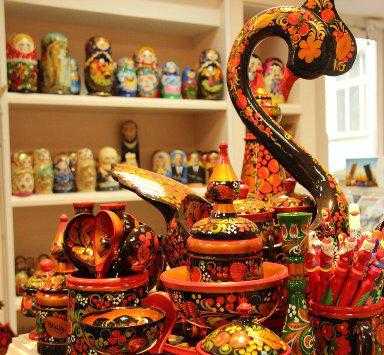
Technique
The art of Khokhloma is a rather complex process involving many technical subtleties. It is not enough to paint the product correctly - its shape and parameters must also be perfect. If the master decided to carve a brother in the form of a swan from wood and paint it in the style of golden Khokhloma, then first of all, the resulting shape should repeat all the grace of the noble bird, and its neck must certainly have a “swan” curve, as we see in nature.
Khokhloma - what is it from a technical point of view? Guided by the rule of authenticity of the product, its compliance with certain canons of a highly artistic level, the specialists of JSC Khokhloma Painting developed a formula for the quality of their products, which formed the basis for the production of Khokhloma products. Thus, all technological processes at the enterprise are subject not to market requirements that stimulate continuous production, but to the laws of the artistic market, oriented towards a buyer with taste. This management policy has already borne fruit; orders began to come not from souvenir shops, but from famous art salons and galleries.
The process of making artistic products in the Khokhloma style is a very complex technological chain. Only hardwood is used, with preference given to linden as the most plastic and responsive material. The material goes through a stage of natural drying in the open air for one year, then the logs and butts are dissolved into blanks, which are dried for another three months. After this, the wood is already suitable for machining on lathes. Selected pieces are used to make nesting dolls, large vases are turned from solid logs. Sapwood is suitable for spoons and ladles; it is quite easy to cut and does not crack.
The turned and cut blanks are called “linen”; before painting, this “linen” is dried again, already at a temperature of about 100 degrees. After this, the products are primed and again loaded into an oven heated to 120 degrees. Then the workpieces are sanded, chips and gouges on the surface are puttied and covered with a thin layer of drying oil. Shortly before complete drying, the workpiece is coated with aluminum powder and rubbed so that the entire surface is evenly covered. Next, silver-matte cups, spoons and saucers, vases and bowls are delivered to the artists for final finishing - Khokhloma artistic painting.
After painting, the products are varnished three times, with intermediate heating to 130 degrees. At the same time, the aluminum coating acquires a golden hue, and the product is ready for packaging and shipping.

Types of painting
In the 18th century, Khokhloma painting reached its culmination, the demand for artistic products was increasing, and Nizhny Novgorod masters at that time were already at the peak of their creativity. It was then that two main types of Golden Khokhloma painting emerged - “mountain” and “background”.
Khokhloma, the patterns of which were drawn in the manner of “horse” painting, is a drawing on a golden field, made with black and red paints. The artist draws an openwork pattern with thin strokes, following any one of the following styles:
- “Gingerbread” is a stylized image of the sun, enclosed in a geometric figure, square, rhombus or faceted circle. The method at first glance is simple, but you couldn’t take your eyes off the solar circle, framed by curlicue rays, so organically did the great luminary combine with the frames surrounding it.
- “Travnik” is a grass ornament, a pattern of sedge coastal or meadow grass.
- “A leaf, under a berry” is a painting with many leaves and berries, flowers and stems, intricately intertwined with each other.
In contrast to the “mountain”, Khokhloma, the patterns of which were applied in gold on a red or black base, was considered “background”. The most interesting type of background painting is “kudrina”, which consists of a stylized image of leaves and flowers. Repeating curly curls, turning into fancy patterns, flowers, foliage and all kinds of berries, garden and forest. This style of painting is also notable for its widespread use of contour strokes in the drawing, which advantageously highlight individual details.
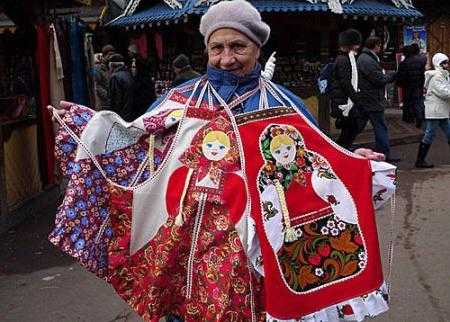
Catalogs
Since the mid-20th century, Khokhloma painting began to be systematized, catalogs with the most interesting copies were printed, and the best were awarded a certificate. The works of master artists in the Khokhloma style, whose photos and sketches were published in the press, became participants in various competitions and exhibitions. The authors of artistic products received prizes and awards for their creativity. At such exhibitions, anyone could purchase a product made in an artistic manner called “Khokhloma”. A souvenir photograph with the master maker was taken right there. For a long time afterwards, the beautiful lacquered thing delighted its owner.
Khokhloma through the eyes of a child
In Soviet times, preschool institutions, kindergartens and even nurseries received furniture made in the style of Khokhloma painting. And although this artistic style has always been considered “adult,” the children sincerely rejoiced at every table painted by the artist. Of course, this was not handmade; the products were painted at a furniture factory using screen printing. But the impression of the high art of Khokhloma painting was present, and the children were happy about it. Their parents rejoiced along with the kids. Thus, children's Khokhloma was no worse than “adult” Khokhloma.
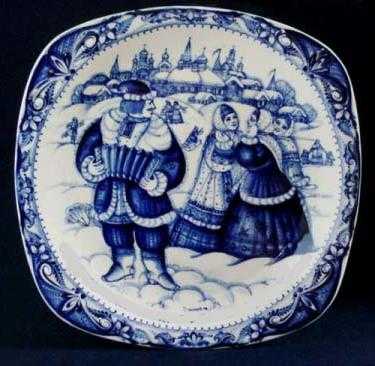
Topic for school essays
The training programs are varied. Khokhloma - what is it, from the teacher’s point of view? In schools in Moscow and the Moscow region, as well as in other Russian cities, the topic of Russian folk arts and crafts is included in educational programs, where the art of Khokhloma painting comes first. Its centuries-old history and worldwide fame provide students with the opportunity to express their personal opinions, put them on paper and receive a grade. This could be an entire essay on a topic or a short story. Khokhloma as an art continues to develop successfully; it is quite worthy of the attention of high school students. However, younger grades can also take part in debates.
